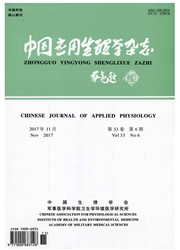

 中文摘要:
中文摘要:
目的:探讨亚油酸对HepG2细胞PAI-1基因表达的影响和调控机制。方法:不同浓度亚油酸刺激HepG2细胞,RT-PCR法检测PAI-1 mRNA水平。构建四个含PAI-1启动子序列从-804至+17间系列缺失体片段驱动的荧光素酶报告基因质粒,转染HepG2细胞,初步确定位于PAI-1启动子序列-804至+17之间的Smad3/4结合元件(SBE)具有调控作用,采用重叠PCR法对该元件进行定点突变并构建相应重组质粒,转染HepG2细胞。WesternBlot法检测亚油酸诱导下HepG2细胞中Smad3和Smad4的蛋白表达水平。结果:①50μmol/L及100μmol/L亚油酸可显著增加PAI-1 mRNA的表达,100μmol/L亚油酸可明显上调PAI-1的转录活性。②亚油酸诱导下,PAI-1启动子-734/-731处SBE缺失后,PAI-1荧光素酶活性显著降低。③亚油酸可以显著增加HepG2细胞中Smad3和Smad4的蛋白表达。结论:亚油酸可从转录水平上调HepG2细胞中PAI-1基因的表达,PAI-1启动子上的Smad3/4结合元件即SBE参与亚油酸对HepG2细胞PAI-1基因的转录调控,这一过程涉及到Smads蛋白及其介导的Smad信号转导通路。
 英文摘要:
英文摘要:
Aim: To investigate the molecular mechanism underlying the effect of linoleic acid on plasminogen activator inhibitor type-1 (PAI-1) expression in HepG2 cells. Methods: HepG2 cells were exposed to different concentrations of linoleic acid and PAI-1 expression was determined by RT-PCR and colorimetric assay. Luciferase reporter gene plasmids containing four sequentially truncated fragments of the PAI-1 promoter region (-804 to + 17) were constructed, and plasmids carrying constructs of Smad binding element (SBE)-site directed deletions in PAI-1 promoter were also generated using overlap extention PER and transiently transfected into HepG2 cdls, the transcriptional activity of PAI-1 was demonstrated by the luciferase activity. The effect of linoleic acid on SmacL3 and Smad4 protein levels in cultured HepG2 cells was measured by Western blot analysis. Results: ①Linoleic acid remarkably incressed PAI-1 mRNA expression and transcription in varying concentrations.②The level of PAI-1 transcription was gradually decreased in- duced by linoleic acid when transfected the SBE-site directed-deletions plasmids in PAI-1 promoter at -734/-731. ③Protein levels of both Smad3 and 4 in HepG2 cells were increased by linoleic acid. Conclusion: Linoleic acid regulated the expression of PAI-1 from transcriptional level in HepG2 cells and SBE involved in the regulation, and both Smads protein and Smad signaling pathway acted main role in this procession.
 同期刊论文项目
同期刊论文项目
 同项目期刊论文
同项目期刊论文
 期刊信息
期刊信息
